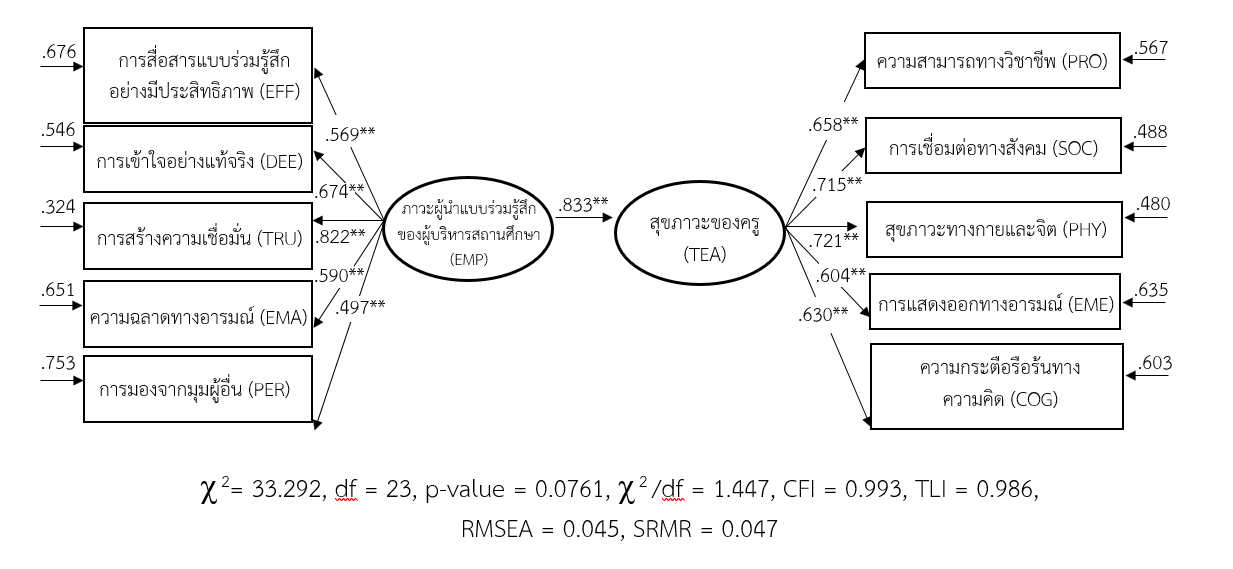โมเดลสมการโครงสร้างภาวะผู้นำแบบร่วมรู้สึกของผู้บริหารสถานศึกษาที่ส่งผลต่อสุขภาวะของครู สังกัดสำนักงานเขตพื้นที่การศึกษาประถมศึกษาขอนแก่น เขต 2
คำสำคัญ:
ภาวะผู้นำแบบร่วมรู้สึก, สุขภาวะของครู, ผู้บริหารสถานศึกษาบทคัดย่อ
การวิจัยมีวัตถุประสงค์เพื่อ 1) ตรวจสอบความสอดคล้องกลมกลืนและวิเคราะห์อิทธิพลของตัวแปรในโมเดลสมการโครงสร้างภาวะผู้นำแบบร่วมรู้สึกของผู้บริหารสถานศึกษาที่ส่งผลต่อสุขภาวะของครูที่ผู้วิจัยพัฒนาขึ้นกับข้อมูลเชิงประจักษ์ และ 2) พัฒนาแนวทางในการพัฒนาภาวะผู้นำแบบร่วมรู้สึกของผู้บริหารสถานศึกษา เป็นวิจัยแบบผสมผสานวิธี โดยแบ่งเป็น 2 ระยะ คือ 1) ตรวจสอบความสอดคล้องกลมกลืนและวิเคราะห์อิทธิพลของตัวแปรในโมเดล กลุ่มตัวอย่างได้แก่ ผู้บริหารสถานศึกษาและครู จำนวน 220 คน ใช้วิธีการสุ่มตัวอย่างแบบหลายขั้นตอน เครื่องมือที่ใช้เก็บรวบรวมข้อมูล คือ แบบสอบถาม มีลักษณะเป็นคำถามปลายปิดเกี่ยวกับภาวะผู้นำแบบร่วมรู้สึกของผู้บริหารสถานศึกษาและสุขภาวะของครู วิเคราะห์โมเดลสมการโครงสร้างโดยใช้โปรแกรม SPSS และ Mplus 2) พัฒนาแนวทางการพัฒนาภาวะผู้นำแบบร่วมรู้สึกของผู้บริหารสถานศึกษา ผู้ให้ข้อมูลคือ ผู้ทรงคุณวุฒิ จำนวน 5 คน เครื่องมือที่ใช้เก็บรวบรวมข้อมูลคือแบบสัมภาษณ์กึ่งโครงสร้าง วิเคราะห์ข้อมูลด้วยการวิเคราะห์เนื้อหา ผลการศึกษาพบว่า 1) โมเดลสมการโครงสร้างภาวะผู้นำแบบร่วมรู้สึกของผู้บริหารสถานศึกษาที่ส่งผลต่อสุขภาวะของครูมีความสอดคล้องกลมกลืนกับข้อมูลเชิงประจักษ์ (χ 2= 33.292, df = 23, p-value = 0.0761, CFI = 0.993, TLI = 0.986, RMSEA = 0.045, SRMR = 0.047) และภาวะผู้นำแบบร่วมรู้สึกมีอิทธิพลทางตรงเชิงบวกต่อสุขภาวะของครู โดยมีขนาดอิทธิพลเท่ากับ 0.833 อย่างมีนัยสำคัญทางสถิติที่ระดับ 0.01 2) แนวทางในการพัฒนาภาวะผู้นำแบบร่วมรู้สึกของผู้บริหารสถานศึกษาประกอบด้วยรายการปฏิบัติตามองค์ประกอบของภาวะผู้นำแบบร่วมรู้สึก จำนวน 13 รายการและมีผลการประเมินแนวทางในระดับมากที่สุด
References
ภาษาไทย
เครือมาศ ชาวไร่เงิน, มานพ ชูนิล และ ปิ่นกนก วงศ์ปิ่นเพ็ชร. (2565). สมดุลสุขภาพกับการทำงานของข้าราชการครูและบุคลากรทางการศึกษากรุงเทพมหานคร. วารสารมนุษยศาสตร์และสังคมศาสตร์มหาวิทยาลัยธนบุรี, 16(1), 152-162.
ถมรัตน์ ศิริภาพ. (2554). อิทธิพลของพฤติกรรมครูด้านสัมพันธภาพระหว่างบุคคลและสุขภาวะของครูที่มีต่อสุขภาวะของนักเรียน: โมเดลการปรับและการส่งผ่านพหุระดับ [วิทยานิพนธ์ปริญญาดุษฎีบัณฑิต ไม่ได้ตีพิมพ์]. จุฬาลงกรณ์มหาวิทยาลัย.
ภัทรวุฒิ วัฒนศัพท์, เสาวนี สิริสุขศิลป์, และ ประกฤติยา ทักษิโณ. (2564). แนวทางการพัฒนาภาวะผู้นำแบบร่วมรู้สึกสำหรับผู้บริหารโรงเรียนเอกชน. วารสารวิทยาลัยบัณฑิตเอเซีย, 11(3), 57-66.
ภัทรวุฒิ วัฒนศัพท์, เสาวนี สิริสุขศิลป์, และ ประกฤติยา ทักษิโณ. (2565). การศึกษาตัวบ่งชี้ภาวะผู้นำแบบร่วมรู้สึกในผู้บริหารโรงเรียนเอกชน: การวิจัยเชิงคุณภาพ. วารสารมนุษยศาสตร์และสังคมศาสตร์ มหาวิทยาลัยนครพนม, 12(1), 137-149.
สมโภชน์ อเนกสุข. (2564). วิธีการเชิงปริมาณ และวิธีการเชิงคุณภาพ สู่วิธีการวิจัยแบบผสม. e-journal of Education Studies, Burapha University, 3(1), 1-16.
สำนักงานเขตพื้นที่การศึกษาประถมศึกษาขอนแก่น เขต 2. (2566). แผนปฏิบัติการ ประจำปีงบประมาณ 2566 (เอกสารหมายเลข 3/2566). กลุ่มนโยบายและแผน.
เสาวนี สิริสุขศิลป์. (2563). ภาวะผู้นำทางวิชาการและการนิเทศการศึกษา. (ฉบับปรับปรุง) เอกสารประกอบการสอน. ขอนแก่น: คณะศึกษาศาสตร์. มหาวิทยาลัยขอนแก่น.
ภาษาอังกฤษ
Acton, R., & Glasgow, P. (2015). Teacher wellbeing in neoliberal contexts: A review of the literature. Australian Journal of Teacher Education (Online), 40(8), 99–114. https://doi.org/10.14221/ajte.2015v40n8.6
Bani-Melhem, S., Mohd. Shamsudin, F., Mazen Abukhait, R., & Quratulain, S. (2021). Paranoid personality and frontline employee’s proactive work behaviours: A moderated mediation model of empathetic leadership and perceived psychological safety. Journal of Service Theory and Practice, 31(1), 113–135. https://doi.org/10.1108/JSTP-05-2020-0104
Bartlett, M. S. (1951). The Effect of Standardization on A χ2 Approximation in Factor Analysis. Biometrika, 38(3–4), 337–344. https://doi.org/10.2307/2332580
Bosetzky, S. (2019). Emerging as an agentic-empathic leader: The effects of a leadership empathy intervention [Doctoral dissertation, European University Viadrina Frankfurt (Oder)]. https://opus4.kobv.de/opus4-euv/frontdoor/index/index/docId/405
Bourgault, P., Lavoie, S., Paul-Savoie, E., Grégoire, M., Michaud, C., Gosselin, E., & Johnston, C. C. (2015). Relationship Between Empathy and Well-Being Among Emergency Nurses. Journal of Emergency Nursing, 41(4), 323–328. https://doi.org/10.1016/j.jen.2014.10.001
Cann, R. (2019). Positive school leadership for flourishing teachers: Leadership actions that enhance teacher wellbeing [Master’s thesis, The University of Auckland]. Libraries and Learning Services. https://researchspace.auckland.ac.nz/handle/2292/49322
Cheng, J.-N. (2013). The Effect of Kindergarten Principals’ Leadership Behaviors on Teacher Work Performance. Social Behavior and Personality: An International Journal, 41(2), 251–262. https://doi.org/10.2224/sbp.2013.41.2.251
Hair, J. F., Hult, G. T. M., Ringle, C. M., Sarstedt, M., Danks, N. P., & Ray, S. (2021). Partial Least Squares Structural equation modeling (PLS-SEM) Using R. Springer, Cham.
Holt, S., & Marques, J. (2012). Empathy in Leadership: Appropriate or Misplaced? An Empirical Study on a Topic that is Asking for Attention. Journal of Business Ethics, 105(1), 95–105. https://doi.org/10.1007/s10551-011-0951-5
Hooper, D., Coughlan, J., & Mullen, M. (2008). Structural Equation Modeling: Guidelines for Determining Model Fit. The Electronic Journal of Business Research Methods, 6(1), 53-60. https://www.researchgate.net/publication/254742561_Structural_Equation_Modeling_Guidelines_for_Determining_Model_Fit
Jian, G. (2021). From Empathic Leader to Empathic Leadership Practice: An Extension to Relational Leadership Theory. Human Relations, 75(5), 1-25. https://doi.org/10.1177/0018726721998450
Kaiser, H. F. (1974). An index of factorial simplicity. Psychometrika, 39(1), 31–36. https://doi.org/10.1007/BF02291575
Kock, N., Mayfield, M., Mayfield, J., Sexton, S., & De La Garza, L. M. (2019). Empathetic Leadership: How Leader Emotional Support and Understanding Influences Follower Performance. Journal of Leadership & Organizational Studies, 26(2), 217–236. https://doi.org/10.1177/1548051818806290
Markowski, C. (2020). Authentic Leadership as an Antithesis to Teacher Burnout [Doctoral dissertation, University of Portland]. https://www.proquest.com/openview/29da0f0514914442bd3d3da780c2440d/1?pq-origsite=gscholar&cbl=18750&diss=y
Maslach, C., Schaufeli, W. B., & Leiter, M. P. (2001). Job Burnout. Annual Review of Psychology, 52(1), 397–422. https://doi.org/10.1146/annurev.psych.52.1.397
Meidelina, O., Saleh, A. Y., Cathlin, C. A., & Winesa, S. A. (2023). Transformational leadership and teacher well-being: A systematic review. Journal of Education and Learning (EduLearn), 17(3), 417-424. https://doi.org/10.11591/edulearn.v17i3.20858
Miao, C., Humphrey, R., & Qian, S. (2016). Leader emotional intelligence and subordinate job satisfaction: A meta-analysis of main, mediator, and moderator effects. Personality and Individual Differences, 102, 13-24. https://doi.org/10.1016/j.paid.2016.06.056
Musil, C. M., Jones, S. L., & Warner, C. D. (1998). Structural equation modeling and its relationship to multiple regression and factor analysis. Research in Nursing & Health, 21(3), 271–281. https://doi.org/10.1002/(SICI)1098-240X(199806)21:3<271::AID-NUR10>3.0.CO;2-G
Nakamura, Y. T., & Milner, J. (2023). Inclusive leadership via empathic communication. Organizational Dynamics, 52(1), 1-7. https://doi.org/10.1016/j.orgdyn.2023.100957
Pines, A. M. (2002). Teacher burnout: A psychodynamic existential perspective. Teachers and Teaching, 8(2), 121–140. https://doi.org/10.1080/13540600220127331
Puertas Molero, P., Zurita Ortega, F., Ubago Jiménez, J. L., & González Valero, G. (2019). Influence of Emotional Intelligence and Burnout Syndrome on Teachers Well-Being: A Systematic Review. Social Sciences, 8(6), 185. https://doi.org/10.3390/socsci8060185
Schumaker, R. E., & Lomax, R. G. (2010). A beginner’s Guide to Structural Equation Modeling. Taylor and Francis Group.
Sharifirad, M. S. (2013). Transformational leadership, innovative work behavior, and employee well-being. Global Business Perspectives, 1(3), 198–225. https://doi.org/10.1007/s40196-013-0019-2
Tarrasch, R., Berger, R., & Grossman, D. (2020). Mindfulness and Compassion as Key Factors in Improving teacher’s Well Being. Mindfulness, 11(4), 1049–1061. https://doi.org/10.1007/s12671-020-01304-x
Tzouramani, E. (2017). Leadership and Empathy. Springer, Cham. https://doi.org/10.1007/978-3-319-31036-7_11
Van Horn, J. E., Taris, T. W., Schaufeli, W. B., & Schreurs, P. J. G. (2004). The structure of occupational well-being: A study among Dutch teachers. Journal of Occupational and Organizational Psychology, 77(3), 365–375. https://doi.org/10.1348/0963179041752718
Viac, C., & Fraser, P. (2020). Teachers’ well-being: A framework for data collection and analysis. OECD Publishing, Paris. https://doi.org/10.1787/c36fc9d3-en
Wibowo, A., & Paramita, W. (2021). Resilience and Turnover Intention: The Role of Mindful Leadership, Empathetic Leadership, and Self-Regulation. Journal of Leadership & Organizational Studies, 29(3), 249-384. https://doi.org/10.1177/15480518211068735
Wilson, C., & Foltz, J. (2013). How to Listen and Be an Empathetic Leader. Feed and Grain Magazine.
Yacoub, H. A. M. (2021). Understanding the Factors Affecting Teachers’ Well-being in Harmony with the Leadership Practices: A Study Among Teachers at a Private School in Dubai [Master’s thesis, The British University in Dubai]. Bspace. https://bspace.buid.ac.ae/items/bc7b4c1d-1a73-4d1d-b18b-807005b7ca5a
Yin, H., Huang, S., & Wang, W. (2016). Work Environment Characteristics and Teacher Well-Being: The Mediation of Emotion Regulation Strategies. International Journal of Environmental Research and Public Health, 13(9), 907. https://doi.org/10.3390/ijerph13090907
Yue, C. A., Thelen, P. D., & Walden, J. (2023). How empathetic leadership communication mitigates employees’ turnover intention during COVID-19-related organizational change. Management Decision, 61(5), 1413–1433. https://doi.org/10.1108/MD-01-2022-0011

Downloads
เผยแพร่แล้ว
How to Cite
ฉบับ
บท
License

This work is licensed under a Creative Commons Attribution-NonCommercial-NoDerivatives 4.0 International License.


